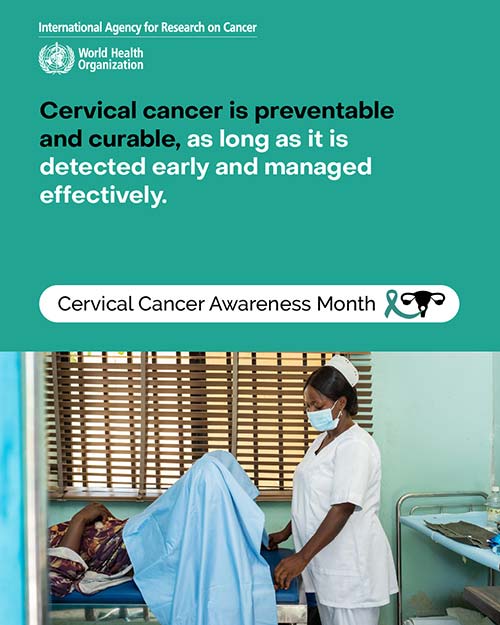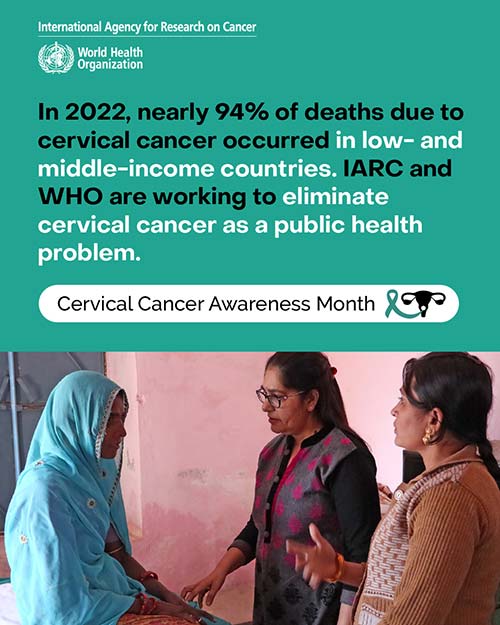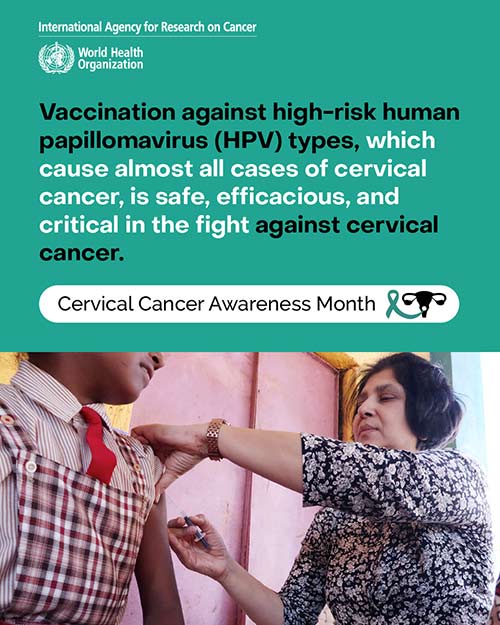
Cervical Cancer Awareness Month 2025 Home
The International Agency for Research on Cancer (IARC) is marking Cervical Cancer Awareness Month by showcasing some of the promising areas of research that could enable countries to eliminate cervical cancer as a public health problem more rapidly.
Cervical cancer is unlike most cancer types because it is mainly caused by persistent infection with a virus: human papillomavirus (HPV). Although HPV refers to a large and extremely common family of viruses, vaccines exist that can prevent persistent infection with the types of HPV referred to as high-risk types. Persistent infection with high-risk HPV types greatly increases a woman’s likelihood of developing cervical cancer. Preventing this infection can prevent almost all cases of cervical cancer.
Recent research by IARC scientists has shown that a single dose of vaccine against HPV offers robust protection against persistent infection with HPV even 15 years after the vaccine is administered. The study also explains how the resulting reduction in HPV positivity rates and requirements for colposcopy within cervical screening programmes will deliver cost savings for health systems that choose this approach – cost savings that can then be reallocated to vaccinate more people or applied to increase screening coverage.
Even with widespread vaccination, screening programmes are, and will remain, a vital tool in the effort to eliminate cervical cancer. The HPV detection test is rapidly becoming the screening test of choice globally, because it can be performed on self-collected samples, it only needs to be done about once every 10 years, and it offers a negative predictive value of close to 100%. However, not all health systems have the resources to appropriately manage women who screen positive for infection with high-risk HPV types.
An ideal triage test for HPV-positive women is lacking. In an effort to fill this gap, IARC scientists, in collaboration with engineers from NSV Incorporated (USA), developed a revolutionary new artificial intelligence (AI) tool that can accurately detect cervical precancers and cancers in images of the cervix taken during appointments for cervical cancer screening. This innovative system, designed specifically for use in low-resource settings, will soon undergo field validation tests in Zimbabwe, potentially providing a tool that will contribute to greater equity in cervical cancer elimination and in global health.
The World Health Organization (WHO) launched the Cervical Cancer Elimination Initiative in November 2020, with the goal of eliminating cervical cancer as a public health problem by 2100. To achieve this, all countries must reach and maintain an incidence rate of fewer than 4 new cases of cervical cancer per 100 000 women per year. Achieving that goal rests on three key pillars and their corresponding targets:
- Vaccination: 90% of girls fully vaccinated with the HPV vaccine by the age of 15 years;
- Screening: 70% of women screened using a high-performance test by the age of 35 years, and again by the age of 45 years;
- Treatment: 90% of women with precancer treated and 90% of women with invasive cancer managed.
Each country should meet the 90–70–90 targets by 2030 to get on the path towards eliminating cervical cancer by the end of this century.
In 2022, more than 660 000 women are estimated to have been diagnosed with cervical cancer worldwide and about 350 000 women are estimated to have died from the disease.
Related IARC news and researchRecent related IARC news and research
- Celebrating the work of front-line workers in the fight against cervical cancer: making a difference among women from all walks of life
- IARC and partners lead colposcopy training course
- IARC hosts meeting of Expert Working Group on cervical cancer to review scientific evidence on screening programmes
- Cervical Cancer Elimination Day of Action 2024: celebrating front-line workers and transforming global commitments into life-saving actions
- A prospective cohort study comparing efficacy of 1 dose of quadrivalent human papillomavirus vaccine to 2 and 3 doses at an average follow up of 12 years postvaccination
- Leveraging single-dose human papillomavirus vaccination dose-efficiency to attain cervical cancer elimination in resource-constrained settings
- Cervix uteri factsheet – Global Cancer Observatory: Cancer Today (GLOBOCAN 2022)
Related IARC atlases
Related IARC atlases
Atlas of visual inspection of the cervix with acetic acid for screening, triage, and assessment for treatment – English, French, Russian, Ukrainian, Spanish
Using HPV tests for cervical cancer screening and managing HPV-positive women – a practical online guide – English, French, Spanish
Atlas of Colposcopy: Principles and Practice – English, Chinese, French, Spanish, Portuguese
PostersPosters
VideoVideo



